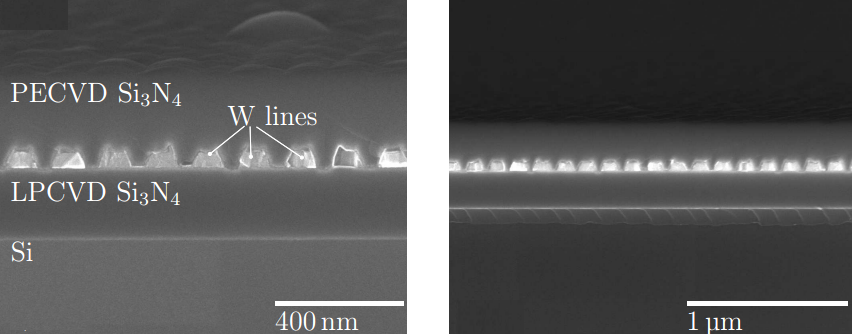A billion-year storage medium that could outlive the human race
October 24, 2013

A QR code etched in tungsten and embedded in graphene oxide on an optical disc Credit: University of Twente)
Researcher Dr. Jeroen de Vries from the University of Twente MESA+ Institute for Nanotechnology suggests we could store data for one million to one billion years, using a new storage medium based on tungsten and graphene oxide.
He imagines two possible scenarios:
- Disaster has devastated the earth and society must rebuild the world
- We need to create a legacy for future intelligent life that evolves on Earth or comes from other worlds.
Optical-disc information carrier
de Vries has developed a novel optical-disc information carrier that he says can store such information for extremely long periods of time, using etching techniques.
A wafer consisting of tungsten (which can withstand extreme temperatures, up to 3,422 degrees C and has a low thermal expansion coefficient) is protected by being encapsulated in silicon nitride (has a high resistance to fracture and a low thermal expansion coefficient).

Left: scanning electron micrograph of the cross-section of the encapsulated lines in the disc test sample; right: scanning electron micrograph of the sample after 1 hour at 200 degrees Celsius (credit: Jeroen de Vries et al./arXiv)
In a test, de Vries etched a QR code into the tungsten. Each pixel of the code consists of a set of much smaller QR codes with pixels of only a few microns in size
The ultimate aging test
To prove that the data would still be readable after millions of years, de Vries did an aging test to see if the energy barriers are high enough to prevent data loss.
The test was based on the Arrhenius model (which predicts how time-to-fail varies with temperature). If a material it is tested by heating to a temperature of 200 degrees Celsius (392 degrees Fahrenheit) and kept in the oven for an hour without damage, it can be assumed that the medium should keep working for at least 1 million years, said De Vries
(This compares well to the The Rosetta Disk, a three-inch-diameter nickel disk with nearly 14,000 pages of information to be microscopically etched onto its surface. It is intended to store one facet of The Long Now Foundation’s 10,000-Year Library — an archive of documentation on over 1500 languages.)
After the test there was no visible degradation of the tungsten, and it was still easy to read the information. However, things become complicated at higher temperatures. When heated to 713 Kelvin (440 degrees Celsius) it becomes a lot more difficult to decipher the QR codes even if the tungsten is not affected.
“A follow-up study would be to investigate whether the data carrier also can withstand higher temperatures, for example during a house fire. But if we can find a place that is very stable, such as a nuclear storage facility, then the disc itself and the data that is on it should be able to endure millions of years.”
But what about physical damage, such as from a meteorite or earthquake?
Protecting from physical damage: holographic coding on graphene oxide

The principle of hologram-encoded multimode recording. Information can be recorded and random accessed in bit sequential mode in the two-photon induced fluorescence change. In the meantime, the accompanied giant refractive-index allows information to be safeguarded in the hologram mode, which can only be retrieved in the diffraction mode. (Credit: Swinburne University of Technology)
For that purpose, Swinburne University of Technology researchers have proposed a different coding system and substrate: holographic coding in a graphene oxide polymer composite, as described in a research paper published in Scientific Reports (open access).
“Conventionally, information is recorded as binary data in a disc. If the disc is broken, the information cannot be retrieved,” Director of the Centre for Micro-Photonics at Swinburne, Professor Min Gu, said.
“This is a major operation cost in big data centres, which consist of thousands of disc arrays with multiple physical duplicates of data. The new material allows the development of ‘super-discs,’ which will enable information to be retrieved — even from broken pieces.”
The graphene-oxide solution
Graphene oxide has properties similar to graphene, which is very strong, light, flexible, nearly transparent, and is an excellent conductor of heat and electricity, but also has a fluorescent property that can be used in bioimaging and for multimode optical recording.
By focusing an ultrashort laser beam onto the graphene oxide polymer, the researchers created a 10–100 times increase in the refractive index of the graphene oxide, along with a decrease in its fluorescence. (The refractive index is the measure of the bending of light as it passes through a medium.)
“The unique feature of the giant refractive-index modulation together with the fluorescent property of the graphene oxide polymer offers a new mechanism for multimode optical recording,” Professor Gu said. “The giant refractive index of this material shows promise for merging data storage with holography for security coding.”
To demonstrate the feasibility of the mechanism, the researchers encoded the image of a kangaroo in a computer generated hologram. The hologram was then rendered as a three-dimensional recording to the graphene oxide polymer. The encrypted patterns in the hologram could not be seen with a conventional microscope, but could be retrieved in the diffracted mode.
“This exciting feature also helps to reduce the operation costs of big data centers that rely on multiple physical duplicates to avoid data loss.” The researchers say it could also revolutionize flat screen TV and solar cell technology.
“It is projected that the new technique will enable new storage discs to be available in market within the next 3 to 5 years,” Gu told KurzweilAI. This technique could also be used for anti-counterfeit holographic tags, using with earth-abundant and environment-friendly materials, he said.
